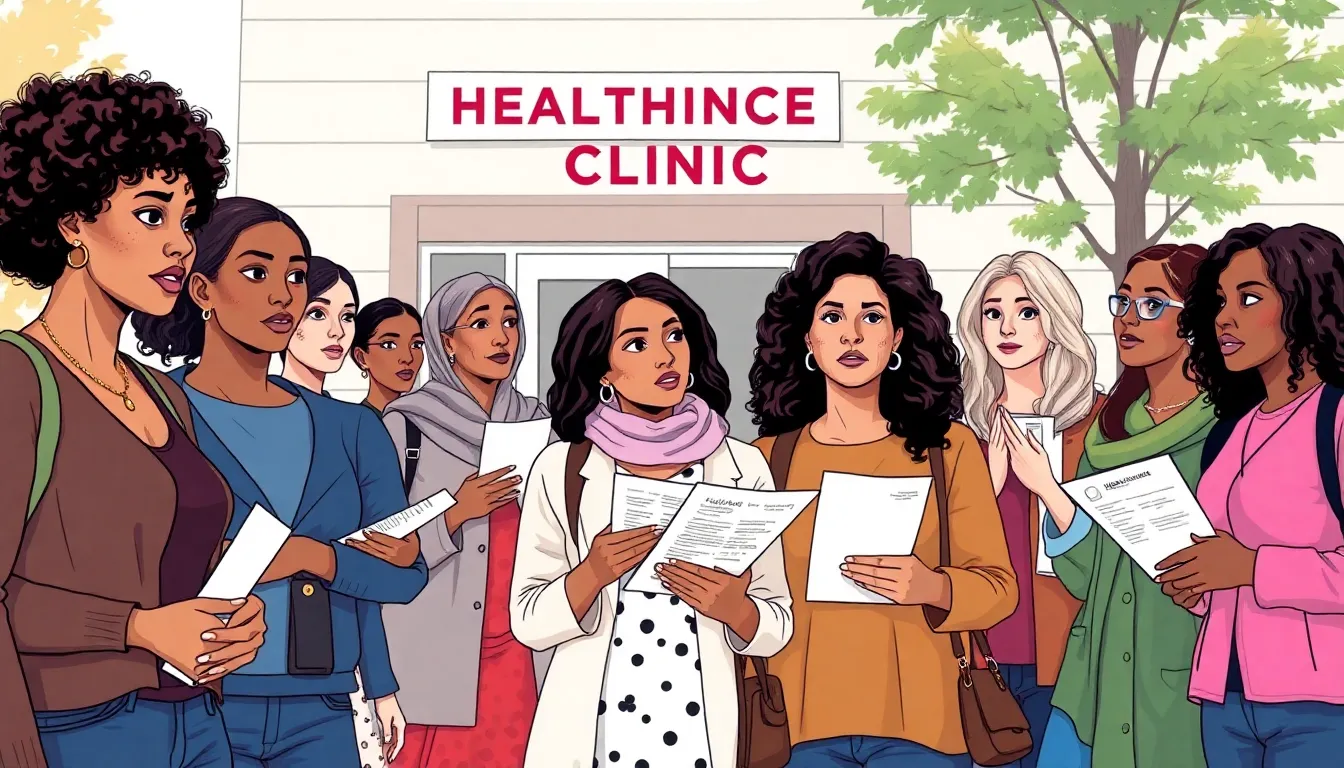Access to healthcare is a fundamental right, yet for many women, it often feels like trying to find a needle in a haystack. Imagine navigating a maze where every turn presents a new obstacle, from financial barriers to lack of information. It’s enough to make anyone want to throw their hands up in frustration.
But this isn’t just a minor inconvenience; it’s a critical issue that affects women’s health and well-being. When women can’t access the care they need, the ripple effects touch families and communities. It’s time to shine a light on the importance of equitable healthcare access for women and explore how breaking down these barriers can lead to healthier lives and brighter futures. After all, everyone deserves to feel their best, and that starts with the right to quality healthcare.
Table of Contents
ToggleOverview of Women’s Access to Healthcare
Women experience numerous challenges accessing healthcare services due to various systemic barriers. Financial constraints play a key role, with many women facing difficulties affording necessary treatments and medications. Lack of insurance contributes to these costs, making it hard for some to seek care when needed.
Cultural and societal factors also hinder access. In some communities, stigma surrounding women’s health issues deters women from seeking help. Additionally, misinformation regarding available services can create confusion and reluctance to utilize healthcare resources.
Geographic disparities exist, particularly in rural areas. Limited healthcare facilities reduce women’s access to essential services, including gynecological care and preventive screenings. Transportation difficulties compound this issue, restricting travel options to health centers.
Data reveals that women of color often face additional obstacles. Systemic racism within healthcare systems results in inequitable treatment and outcomes. Research by the National Women’s Law Center indicates that nearly 20% of women identify cost as a primary barrier to care.
Legal restrictions on reproductive health services further complicate access for women. Many states impose regulations that limit service availability, impacting women’s rights to make informed healthcare choices.
Efforts to improve women’s access to healthcare must address these interconnected challenges. Advocacy for policy changes and increased funding for women’s health programs can drive progress. Providing education about available resources and services fosters awareness and encourages utilization. Only through comprehensive action can barriers be dismantled, allowing women to achieve better health outcomes.
Barriers to Accessing Healthcare

Accessing healthcare presents significant barriers for women. These obstacles often result in poor health outcomes and negatively affect families and communities.
Socioeconomic Factors
Socioeconomic factors play a crucial role in healthcare access. Financial constraints frequently limit women’s ability to seek necessary services. Lack of insurance remains a significant hurdle, which affects approximately 15% of women in the U.S. Cultural stigma around certain healthcare needs may discourage women from pursuing available care. Employment differences contribute to these disparities, as part-time or low-wage jobs often lack healthcare benefits. Education about resources helps mitigate these challenges, yet misinformation continues to persist.
Geographic Limitations
Geographic limitations significantly hinder women’s access to healthcare services. Rural areas often lack essential healthcare facilities, forcing women to travel long distances for care. Nearly 60 million people in the U.S. live in areas designated as health professional shortage zones. Transport difficulties magnify this issue, especially for those without reliable vehicles. Public transportation options may be limited, further isolating women in need. Telehealth services provide one alternative, but not all women can utilize technology effectively. Addressing these geographic constraints is vital for ensuring equitable healthcare access.
Importance of Comprehensive Healthcare
Accessing comprehensive healthcare plays a crucial role in enhancing women’s overall well-being. Prioritizing women’s unique health needs ensures better outcomes for families and communities.
Maternal Health
Maternal health significantly affects both mother and child. Inadequate access to prenatal care contributes to complications during pregnancy and childbirth. Approximately 700 women in the U.S. die from pregnancy-related causes each year, highlighting the urgency for better maternal health services. Comprehensive care provides essential screenings and guidance throughout pregnancy. Support systems, including mental health resources, also make a notable difference. Ensuring access to skilled care and support before, during, and after childbirth aids in reducing maternal mortality rates, ultimately fostering healthier families.
Preventive Services
Preventive services represent a foundational aspect of women’s healthcare. These services include regular check-ups, screenings for diseases, and vaccinations. Access to preventive care reduces the occurrence of chronic illnesses such as breast and cervical cancer. Data indicates that women who receive regular preventive services experience improved health outcomes. Resources like mammograms and Pap smears provide early detection, leading to timely interventions. Expanding access to these essential services ensures that women maintain their health, which benefits families and communities alike.
Policies and Initiatives Addressing Access
Various policies and initiatives strive to improve women’s access to healthcare. These efforts aim to transform the landscape of healthcare, addressing identified challenges.
Government Programs
Government programs play a crucial role in enhancing access to women’s healthcare. Medicaid expansion, for example, extends coverage to millions of low-income women, reducing financial barriers. The Women, Infants, and Children (WIC) program provides essential nutrition services and breastfeeding support. Title X funding supports family planning services, offering preventive care and education. Furthermore, the Affordable Care Act includes provisions that prevent insurance discrimination based on gender. Such programs actively work to ensure women receive the healthcare they need without added financial strain.
Nonprofit Involvement
Nonprofit organizations significantly contribute to improving women’s healthcare access. They often provide essential educational resources, helping women understand their health rights and available services. Groups like Planned Parenthood offer comprehensive services, including reproductive health care and preventive screenings. Programs led by the National Women’s Health Network advocate for policy changes that benefit women’s health. Community-based organizations frequently mobilize to address localized concerns, making healthcare resources more accessible. These collaborative efforts foster a supportive environment, empowering women to seek necessary health services.
Future Directions for Improvement
Enhancing women’s access to healthcare requires targeted strategies that address existing barriers. Investing in community health initiatives improves availability and education regarding healthcare options. Policymakers must prioritize expanding Medicaid, which currently covers a significant portion of low-income women, promoting early intervention and preventive care.
Increasing financial support for women’s health programs can significantly reduce the strain on low-income families. Studies show that programs like WIC and Title X successfully provide essential resources, making healthcare services more accessible. Strengthening these programs not only supports women’s health but also fosters healthier families.
Collaboration among healthcare providers, nonprofit organizations, and community leaders can create a more unified approach to healthcare delivery. Integrating telehealth services into regular healthcare offerings increases accessibility for women, particularly those in rural areas. Training providers on the unique health needs of women can improve the quality of care received.
Developing educational campaigns that dismantle cultural stigma around women’s health issues encourages more women to seek necessary care. Emphasizing maternal health resources can decrease maternal mortality rates, which currently see approximately 700 deaths annually in the U.S. due to pregnancy-related complications.
Expanding access to preventive services like screenings and regular check-ups directly influences health outcomes. Research indicates that these services significantly reduce chronic illnesses such as breast and cervical cancer.
Advocating for comprehensive healthcare policies not only benefits women but also enhances community well-being. Engaging women in discussions about their health rights fosters empowerment and paves the way for informed healthcare choices.
Addressing women’s access to healthcare is essential for fostering healthier families and communities. The barriers women face are complex and multifaceted, requiring targeted solutions and collaborative efforts. By prioritizing comprehensive care and preventive services, society can significantly improve health outcomes for women.
Investing in community health initiatives and expanding Medicaid can alleviate financial burdens while dismantling cultural stigmas encourages women to seek necessary care. Engaging women in discussions about their health rights empowers them to make informed choices.
Ultimately, enhancing women’s access to healthcare not only benefits individual health but also strengthens the fabric of society as a whole. It’s imperative that stakeholders work together to create a more equitable healthcare system that serves all women effectively.




